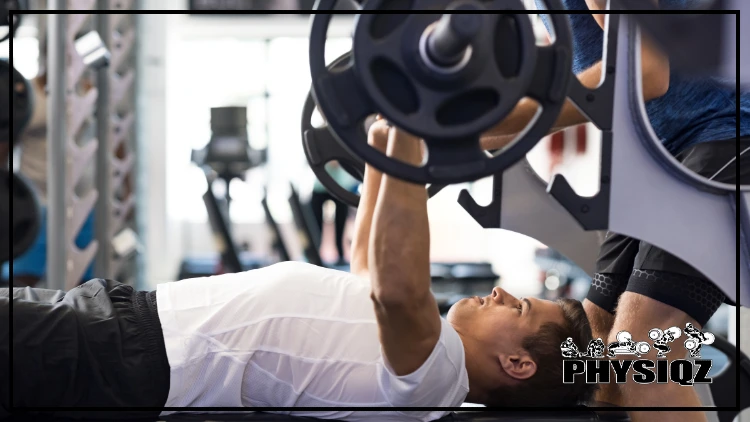
On the close grip bench press, muscles worked include the chest, triceps, shoulders, teres major, forearms, core, erector spinae, and hip flexors but there are several different muscles within each of these muscles groups.1
The close grip chest press works many of the same muscles as a medium or wide grip bench press and those performing them to emphasize triceps will be pleased to know that studies suggest there is approximately 10% more activation in the triceps when comparing a traditional grip vs close or narrow grip bench press.
With that being said, the reason why lifters may consider avoiding the close grip bench press for triceps exercise is because it’s lackluster in targeting all 3 heads, primarily the long head. For this reason, the close grip chest press shouldn’t be used as the sole exercise for triceps and instead, overhead tricep exercises should be done to work the long head as well.
Below we’ll cover the differences between normal bench press and the close grip chest press, the muscles worked in each, as well as how to hit all 3 heads of the trciep, include the long vs short heads.
The Close Grip Bench Press
The close grip chest press is a variant of the more famous wide grip bench press that has the lifter use a narrower grip width that typically results in more emphasis placed on the triceps muscles. However, due to the reduced grip width, the result is that the bar has a longer distance to travel and therefore longer range of motion (ROM).
This means that typically, the close grip chest press cannot be done with as much as a heavy load as its wider grip counterpart.
That said, the close grip chest press is considered one of the ‘greats’ in powerlifting and bodybuilding workout plans because it not only builds and grows the triceps but can also help lifters push through plateaus they may face in the regular bench press. Training plateaus occur when lifters are no longer making real concrete gains when doing the same exercise routine which results in the body adapting and becoming efficient at the exercise.
This often leads to burning fewer calories and a halt in hypertrophy (muscle growth) gains.
Differences Between Close Grip Bench Press vs Traditional Bench Press
There are several key differences between the close grip bench and traditional press with some being apparent to the common eye including different grip widths, range of motion and load that can be lifted.
Grip Widths
One of the most noticeable differences and also due to the origin of the name of the exercise, is that the close grip chest press is performed with a narrower (close) width than the standard bench that has a wider width. The close grip bench typically has a grip that is at shoulder or slightly within shoulder width.
Conventional bench generally has a grip width that is wider than shoulder width—between 1.5 to 2 times shoulder widths.
Range of Motion & Movement Pattern
Due to the narrower grip of the close grip chest press, there is an increased range of motion because there is a longer distance to the chest. As a result, the bar touches the chest just below the sternum, which is slightly lower than the conventional bench press.
With the wide grip bench, the bar travels a shorter distance and the bench press bar path terminates and touches at about the nipple line, resulting in a smaller range of motion.
Load & Speed Differences
The longer ROM of the closed grip bench means that muscles spend more time under tension (the time under which a muscle is stretched under load) resulting in the lifter not able to lift as heavy as they would on the wider grip bench press. Typically, lifters are about 6% stronger in the wider grip bench press; conversely, lifters are generally able to lift 90% of the load in the closed grip bench press that they would in the wide grip.
Close grip chest press results in higher speed and power, while the wider grip bench produces a higher force. This has the implication that the close grip is better for sports where speed and power are on demand, and the wide grip where raw, brute strength is required.
Muscles Worked
The grip width has a profound effect on the muscles worked. In the close grip bench press, the chest and shoulders contribute roughly 63% of the pressing force, with the triceps providing 37%.
In the wide grip bench press, the numbers vary significantly with the triceps contributing 22% of the pressing force and the shoulders and pecs receiving a higher activation resulting in a combined total of 78%.2
This means that the close grip chest press is an exercise that is much superior at activating the triceps when compared to the regular press.
Different Stress Points
Close grip chest press places more torque through the elbow joint due to the increased triceps engagement. The wide grip bench press demands more from the shoulders and rotator cuffs.
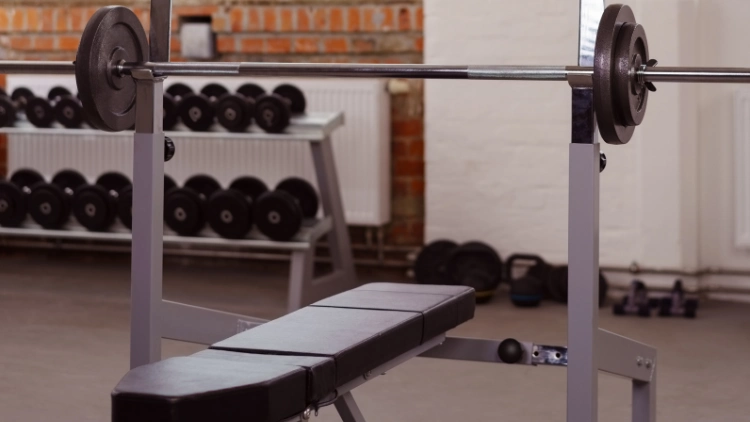
Source: stockfour via Canva.com3
Close Grip Bench: What Are the Close Grip Bench Press Muscles Worked?
As previously mentioned, the close grip results in a different focus on the activation of the typical bench press muscles worked—the close grip chest press continues to enlist the pecs (chest muscles) and triceps as the primary movers with the triceps taking an increased role due to the narrower grip. The close grip bench press muscles worked include the anterior deltoids (front shoulders) as stabilizers and the teres major.
Triceps (Lateral & Medial Head)
The close grip chest press will place a greater emphasis on the triceps when compared to the other primary movers, the chest muscles and the front deltoids.4 A narrower grip alters the path of the bar with the end of the bar path being below the sternum which is a slightly lower position than that of the conventional bench press.
Lateral and medial heads of the triceps muscles receive the most activation with the long head playing a diminished role.
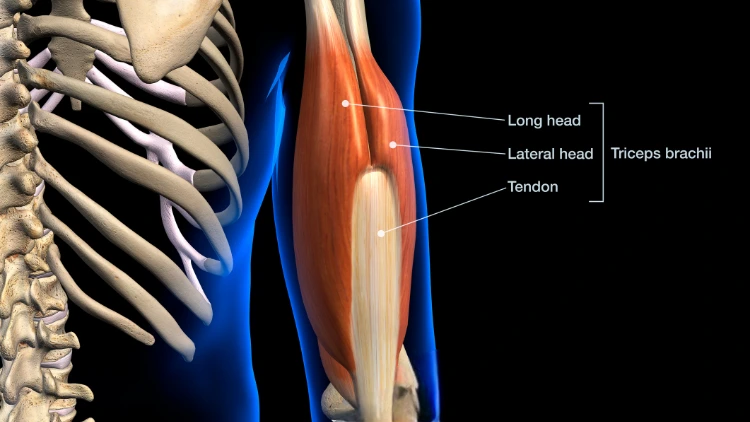
Source: Hank Grebe via Canva.com5
The close grip chest press is an ideal triceps exercise for those wondering why their arms won’t grow, as it provides superior triceps activation.
Chest Muscles (Upper Pecs)
The close grip chest press activates the upper pec chest effectively, a study conducted in 1995 showed that this type of movement increased activation in the clavicular head of the pectoralis major.6 This is the section of the pecs closest to the shoulders and collarbone.
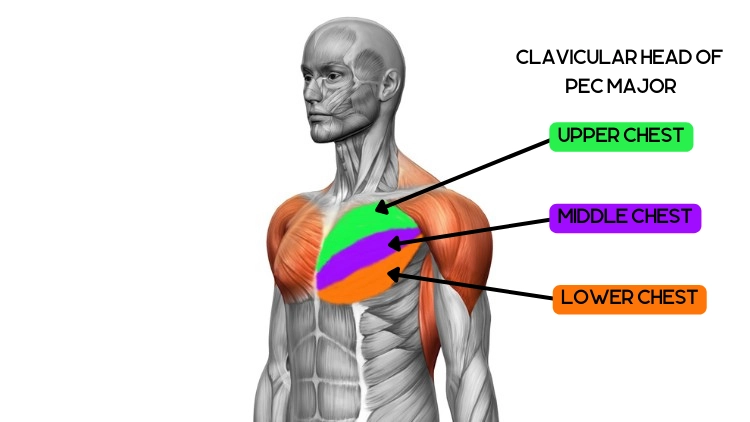
Source: Science Photo Library via Canva.com7
Shoulder Muscles (Front Deltoids, Rotator Cuff)
Close grip chest press does not recruit the shoulder muscles as much as its wider grip counterpart—not much shoulder power is required to complete the exercise. [3] This makes the closed grip a viable candidate for those who may be experiencing shoulder pain while bench pressing.
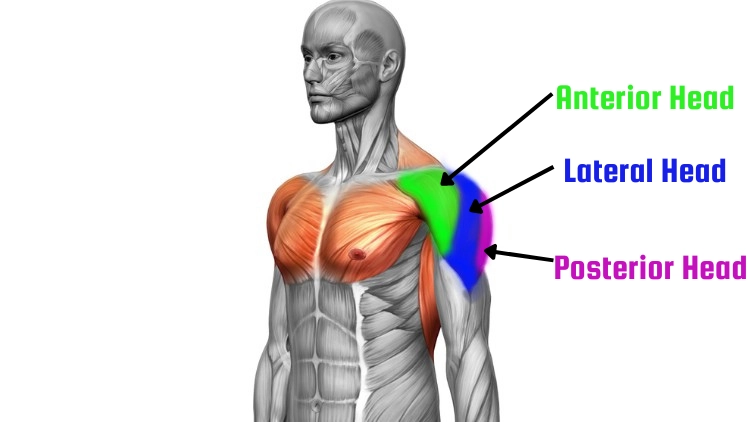
Source: Science Photo Library via Canva.com
However, it should be noted that closed grip may also cause elbow and somewhat shoulder discomfort for some lifters due to differing anatomies.
Rotator Cuff (Supraspinatus, Infraspinatus)
These muscles make part of the rotator cuff muscles and help to stabilize the shoulder joint during the movement.
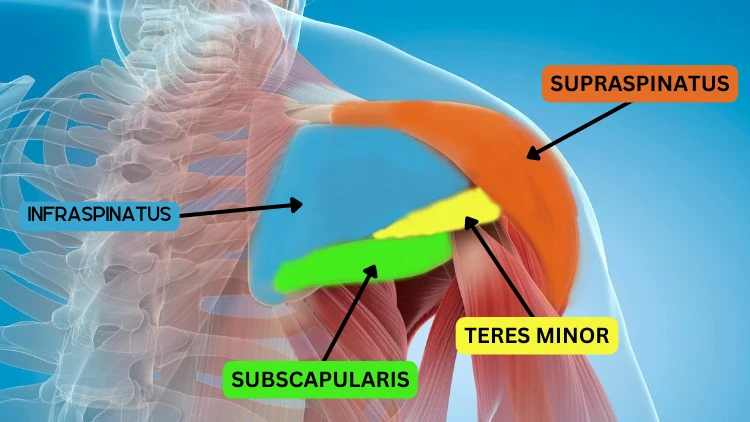
Source: Science Photo Library via Canva.com8
Teres Major
The teres major is a thick and rectangular muscle that is also flat and extends from the humerus (upper arm bone) to the inferior posterior scapula (shoulder blades) that is responsible for internal shoulder rotation. It has a major role just like the front deltoids, in stabilizing the movement while helping to internally rotate the shoulder.
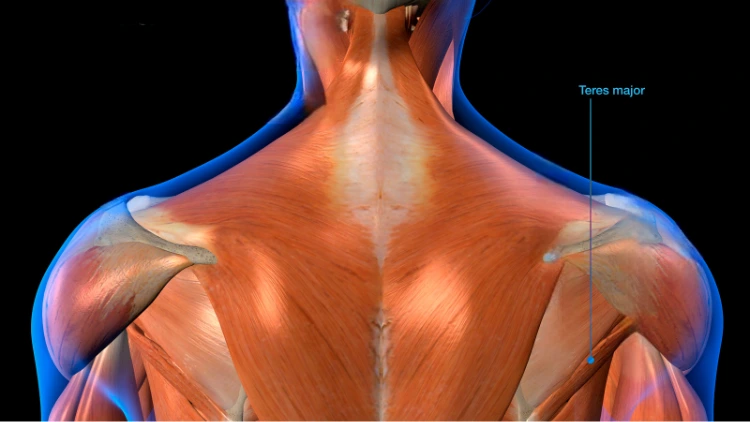
Source: Hank Grebe via Canva.com9
Forearms
The forearms are among the close grip chest press muscles performed and provide a pivotal role in the movement and are the link between the wrists and hands that are holding the bar providing a medium for which the pushing energy from the primary muscles travels through to the bar.
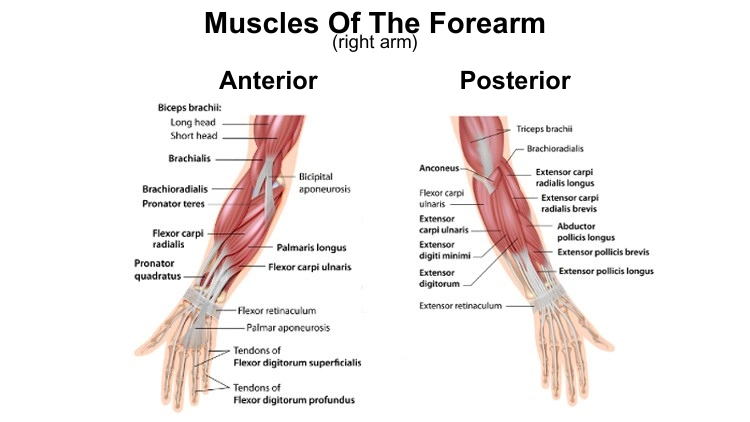
Source: Alila Medical Media on Shutterstock10
Core Muscles (Abdominals), Erector Spinae, & Hip Flexors
These muscles all help to keep the torso firm and rigid, maintaining tension and allowing the body to be a firm base and pillar from which to press the weight.
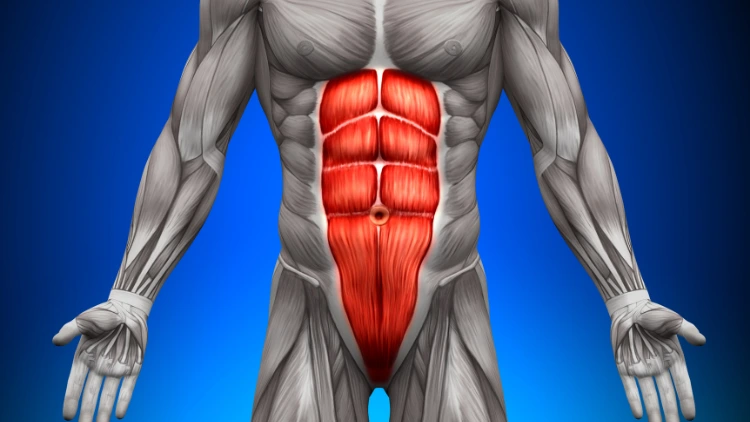
Source: decade3d via Canva.com11
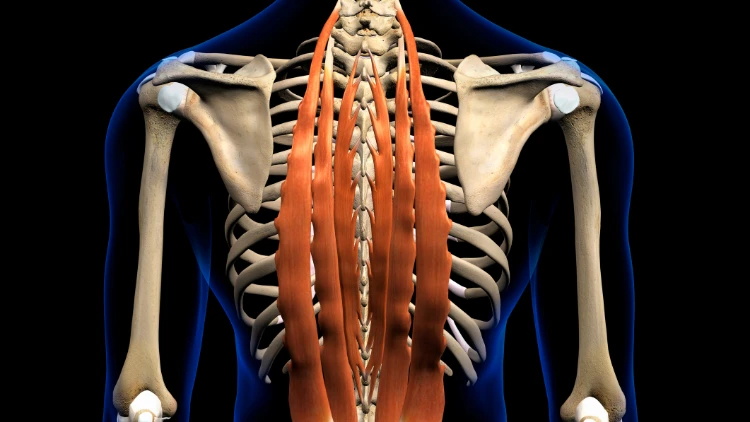
Erector spinae. Source: Hank Grebe via Canva.com12
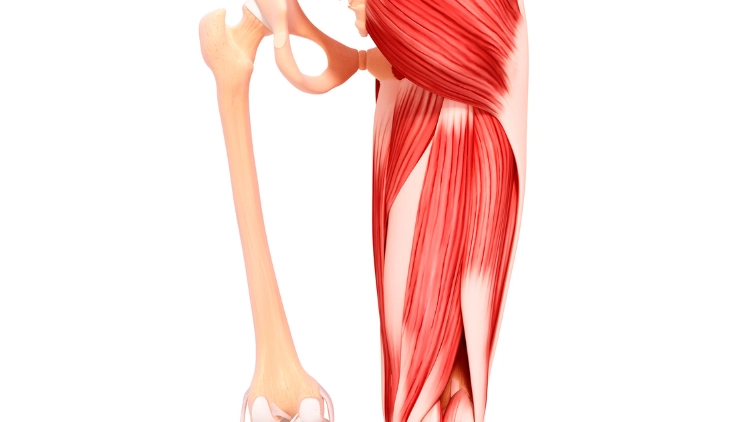
Hip felxors. Source: Science Photo Library via Canva.com13
How To Perform a Close Grip Bench Press With Proper Form & Technique
For lifters to take full advantage of what the close grip chest press has to offer, the exercise must be done with correct form and technique to effectively build muscle and prevent injury. Lifters should pay attention to grip width, elbow position and increase the time under tension.
Use the Correct Grip Width
The triceps are the primary muscles for the close grip bench and one of the main reasons why the grip chosen is narrow. Therefore, to effectively feel the triceps and get them to be the focus of the movement, the correct grip width must be employed.
The most optimal and efficient position for this is 95%-100% of the biacromial distance (distance between shoulder blades) for the closed grip bench press.14
This grip width is the sweet spot between having too narrow a grip which will cause internal shoulder rotation and stress to the wrists, and too wide a grip which demands more from the chest muscles.
Increase the Time Under Tension (TUT)
To activate and engage the triceps muscle substantially in the exercise, lifters could increase the already higher time under tension the muscles experience when compared to the wide grip bench press. When muscles have an increased time under tension, muscle activation is increased significantly, which leads to higher hypertrophy rates.15
This is accomplished by slowing the movements, and because the triceps are responsible for the lockout phase of the movement, lifters can include either a pause and/or tempo (rate of speed) in the last two thirds of the movement. Essentially, time under tension can increase either by adding up to 3 seconds when the bar is halfway off the chest or add anywhere between 3 and 4 seconds for a tempoed ascent.
Position the Elbows Correctly
Having the correct elbow position is critical to a successful and efficient press—the elbows need to remain either inline or a tad in front of the bar when on the chest. This position allows for better triceps involvement when extending the elbows providing the lifter with a mechanical advantage to press the bar to a slightly back locked position.
In addition, this position permits the stacking (aligning) of the wrist and elbow joint, keeping them in a safe and efficient pressing position.
Avoid Flaring the Elbows
Elbow flaring is a common mistake in the close grip chest press. When elbows are flared in the close grip chest press, focus is transferred away from the triceps to the chest and shoulder muscles, thus defeating the purpose of the movement.
The reason why many lifters flare the elbows is because of weak triceps when struggling with the bench press.
This is due to the body trying to adapt to the movement and complete what is demanded from it—this forces it to look to the larger muscles which in this case are the chest and shoulders.
Therefore, every effort should be made to keep the elbows tucked towards the torso even if it means going lighter on the weight that their triceps can handle. However, they should not be overly and aggressively tucked to a point where they are touching the torso and are now placed inside the wrists causing strain.
Isolate the Lockout Position
A good practice to target the triceps even more would be to isolate them at the lockout stage of the exercise by restricting the ROM allowing for a full focus on the triceps. This can be achieved by using boards that are placed on the chest; this is actually a close grip chest press alternative known as the board bench press.
This technique emphasizes the triceps which are used in the lockout and allows for a more aggressive loading of the triceps since the ROM is reduced by board.
Retract Your Shoulder Blades & Brace Your Core
Keep the shoulder blades retracted to ensure there is less pressure placed on them. The core and glutes should be braced at all times to keep tension in the body to allow it to be a firm base to press from.
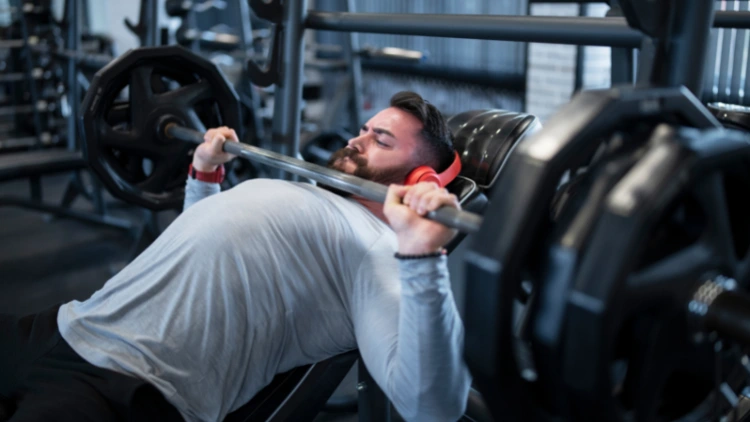
Source: ArtistGNDphotography via Canva.com16
How To Target All 3 Tricep Heads on the Close Grip Bench Press & Beyond
The close grip chest press effectively targets most of the triceps muscles, primarily focusing on the lateral head and to a lesser extent, the medial head and the close grip bench press muscles worked during this exercise.
Triceps muscle is composed of 3 heads, namely the lateral, medial and long heads. The long head does not get activated much in this movement because it traverses (crosses) both the shoulders and elbow joint.
Hence, during the movement it shortens in one phase and lengthens in the other; as a result, it does not get sufficient contraction and tension. The long head requires overhead exercises and/or isolation exercises such as the incline dumbbell kicks.
In this respect, the close grip bench is not the most efficient exercise at targeting all three heads of the triceps; in fact diamond push ups are better at activating the triceps long head vs short in the close grip chest press. Additionally, when a lifter elects to perform the close grip bench in an incline, there is little change on the triceps engagement and activation compared to the flat close grip chest press.
The close grip chest press can assist lifters with poor triceps genetics in overcoming their deficiencies, especially when paired with other triceps exercises like skull crushers, diamond pushups, weighted dips, and overhead exercises such as overhead cable and dumbbell triceps extensions.
Alternative Exercises To the Close Grip Bench Press
Lifters have several alternatives to the close grip bench press, including the close grip pin press, close grip Smith machine press, and close grip push-ups. These alternatives may be used by lifters who may have challenges with the close grip chest press due to the odd position that the elbows and wrists are placed in, are looking for more ROM or simply wanting to bring variety into their regimen.
For whatever reason, these are some alternatives exercises available, including some that use only body weight as resistance:
- Close grip pin press
- Board bench press
- Close grip smith machine
- Close grip dumbbell press
- Close grip Ez press
- Close grip push-ups
- Triceps dips
- Diamond pushups
- Neutral close grip dumbbell pushups
- Dumbbell floor press
- Dumbbell bench press
- Close grip with chains
- Svend press
Common Mistakes When Dialing in the Close Grip Bench Press
Lifters often find themselves making a number of close bench press mistakes that often compromise their form and technique which makes for an inefficient exercise that doesn’t build muscle well and places them at risk for injury. These include:
- Flaring the elbows too much that takes focus away from the triceps.
- Having the elbows too far behind or ahead of the bar which shifts focus away from the triceps to other muscles.
- Incorrect grip width that is too narrow.
- Another common mistake is that lifters bounce the bar off the chest and have inconsistent touch points.
- Not using the full ROM unless when adopting techniques that attempt to engage the triceps more like in the board bench press.
- Ego lifting by using more weight than can be handled resulting in a technique breakdown
- Descending the bar too quickly.
Sets & Reps for Close Grip Bench Press
The number of sets and reps that a lifter should perform will largely depend on their training objectives and what they are ultimately looking to get from the program. There are typically two main objectives for strength training; building muscle and getting stronger.
Studies have concluded that when resistance training is performed with strength goals, heavy loads at 80%-100% of 1RM should be used for 1-5 reps; while programs that call for moderate loads at 60%-80% of 1RM and done in the 8-12 rep range are ideal for hypertrophy.17 The one rep max (1RM) is the maximum weight that a lifter can haul in one rep.
With that being said, these are recommended sets and reps for:
Building Muscle—4 sets x 10 reps @ 75% of 1RM.
Increasing Strength—4 sets of 6 reps @ 65% of 1RM.
Incorporating Close Grip Bench Press Into the Ultimate Chest & Tricep Workout
The close grip chest press appears in a number of workout programs for beginners and novice lifters alike and those with either strength or muscle building goals in mind. The close grip chest press is included in many workout programs, such as the 6-day workout routine plan and the Nsuns 531 Cap3 routine.
These programs below are for individuals looking to build muscle and those looking to develop raw strength to getting stronger.
Upper Split Workout for Raw Strength
The upper split workout program for raw strength below is a typical powerlifting program which generally has lifters perform upper/lower splits where they dedicate a day to the upper body and a subsequent day to the lower body. Here’s a sample from the 8-week powerlifting program, including the close grip chest press and other upper body exercises for a workout.
| Exercise | Sets X Reps |
| Bench press | 5 X 3 @ 75% of 1RM |
| Close grip chest press | 5 X 10 |
| Pull-ups | 5 X 10 |
| Dumbbell flies | 3 X 10 |
| One arm dumbbell row | 3 X 10 |
| Rear delt flies | 5 X 10 |
| Curls (these are optional) | |
| Triceps pull-downs (these are optional) |
Chest & Tricep Workout To Build Muscle
This workout sample is for lifters that are looking to build muscle and incorporates the close grip chest press where the lifters target the triceps, chest and shoulders on the same day—known as a push day workout. Below is a sample of the Coolcicada PPL push pull legs routine from the Bodybuilding forum, which is compared to the Reddit PPL routine made famous by Reddit user Coolcicada.
However, the close grip chest press is swapped for the overhead dumbbell extension—the user points out that another triceps exercise can be included instead.
| Exercise | Sets X Reps |
| Flat barbell bench press | 3 x 5 |
| Seated (or standing) barbell shoulder overhead press | 3 x 5 |
| Incline barbell bench press | 3 x 5 |
| Dumbbell side lateral raise | 3 x 10-12 |
| Rope pushdowns (circuit machine) | 3 x 10-12 |
| Close grip chest press | 3 x 10-12 |
| Shrugs (circuit machine or dumbbells) | 3 x 10-12 |
The close grip chest press is an ideal variant to the conventional bench press that has been tried and tested and can contribute to an impressive upper body.
The close grip bench press muscles worked primarily work the triceps due to the change in grip, leading to increased engagement, along with the pecs, shoulders, and other stabilizing muscles, but it may not be ideal for those seeking to activate the long head vs short head of the triceps, as it targets the lateral and medial (short) heads better.
Frequently Asked Questions
How Narrow Should the Grip Be on a Close Grip Chest Press?
Grip width on the bench press should be the shoulder width or slightly inside the shoulder width. The hands should never touch or be less than 6 inches between them.
Does Close-Grip Bench Press Work All the Triceps Heads?
The close grip does work primarily the lateral and to a lesser extent, medial head of the triceps muscle.
Does Close Grip Build the Upper Pecs?
Surprisingly and not known to many, the close grip does engage the upper pecs, more so than the flat barbell bench press.
Close Grip Chest Press vs Close Grip Dumbbell Bench Press: Which Is Better for Muscle Growth?
Both exercises are great for muscle growth. Lifters can go heavier on the close grip chest press compared to dumbbells, which means they have the potential to develop more raw strength. However, the dumbbell press affords lighter weight and can increase more muscle activation due to an increased ROM and also address muscle imbalances.
Who Should Perform the Close Grip Chest Press?
The close grip chest press much like its sibling wider grip bench press suits most strength athletes. Powerlifters and strongmen use it to build triceps strength and improve on lockout. Weightlifters and cross fitters use it as an accessory, since it focuses on elbow extension that can transfer to movements like the clean and jerk. Bodybuilders use it to sculpt their triceps and upper chest.
Sports athletes like basketballers, boxers and footballers stand to gain the strength and power it confers on elbow extension. Lastly, average gym goers can use it to improve on their bench press forms and lockouts by building stronger and bigger triceps.
What Are the Disadvantages of the Closed Grip Bench Press?
The close grip chest press does have some drawbacks due to the awkward placement. It significantly increases the ROM which means that lifters cannot lift heavy as they would on the wider grip version. In addition, the close grip places extra stress on the elbow joint which may be an issue for those with elbow pain.
Are the Close Grip Chest Press Muscles Performed the Same As Wide Grip Bench Press?
The muscles worked by the close grip chest press and wide grip bench press are essentially the same. However, what is different is how they focus on these muscles. The close grip chest press exaggerates triceps and upper chest muscles while the wide grip bench press has the pecs and front delts taking a more dominant role with the triceps having a slightly less diminished role.
Is Close Grip Floor Press for Triceps?
Yes, the close bench press is a triceps focused exercise and is used to develop and build triceps strength and muscle.
References
1Rido. “Man Doing Bench Press.” Canva. Accessed 12 April 2023. <https://www.canva.com/photos/MACV1xKu8G8-man-doing-bench-press/>
2Lehman, G. J. (2005, August 19). The influence of grip width and forearm pronation/supination on upper-body myoelectric activity during the flat bench press. Retrieved 2023, from <https://pubmed.ncbi.nlm.nih.gov/16095407/>
3stockfour. “Barbell on bench press rack.” Canva. Accessed 12 April 2023. <https://www.canva.com/photos/MADme2RcFFU-barbell-on-bench-press-rack/>
4Robert G. Lockie, S. J.-B. (2017, June 24). An Investigation of the Mechanics and Sticking Region of a One-Repetition Maximum Close-Grip Bench Press versus the Traditional Bench Press. Retrieved 2023, from <https://www.ncbi.nlm.nih.gov/pmc/articles/PMC5968970/>
5Hank Grebe. “Labeled Anatomy Chart of Shoulder, Elbow and Triceps Muscles in Skeleton on Black Background.” Canva. Accessed 12 April 2023. <https://www.canva.com/photos/MAEJnzTxmJU-labeled-anatomy-chart-of-shoulder-elbow-and-triceps-muscles-in-skeleton-on-black-background/>
6Barnett, C. K. (1995). Effects of variations of the bench press exercise on the EMG activity of five shoulder muscles. Retrieved 2023, from <https://espace.library.uq.edu.au/view/UQ:714265>
7Science Photo Library. “The muscles involved in standing biceps curl. The stabilizing muscles are highlighted.” Canva. Accessed 12 April 2023. <https://www.canva.com/photos/MADmTGwAFbo-the-muscles-involved-in-standing-biceps-curl-the-stabilizing-muscles-are-highlighted-/>
8Science Photo Library. “”Shoulder muscles.” Canva. Accessed 12 April 2023. <https://www.canva.com/photos/MADmTDg8VA4--shoulder-muscles/>
9Hank Grebe. Canva. Accessed 22 April 2023. <https://www.canva.com/photos/MADZAeIzfnc-labeled-anatomy-chart-of-neck-and-shoulder-muscles-on-black-background/>
10Alila Medical Media. “Muscles Forearm Anterior Posterior View Stock Illustration 147943889.” Shutterstock. Accessed 22 April 2023. <https://www.shutterstock.com/image-illustration/muscles-forearm-anterior-posterior-view-147943889>
11decade3d. “Abs – Anatomy Muscles.” Canva. Accessed 12 April 2023. <https://www.canva.com/photos/MADerFwn3js-abs-anatomy-muscles/>
12Hank Grebe. “Male Erector Spinae Back Muscles in Isolation on Skeleton.” Canva. Accessed 12 April 2023. <https://www.canva.com/photos/MAD8-XkZ3xQ-male-erector-spinae-back-muscles-in-isolation-on-skeleton/>
13Science Photo Library. “”Human musculature.” Canva. Accessed 12 April 2023. <https://www.canva.com/photos/MADmTB-2Tfo--human-musculature/>
14Nicholas A Burd, R. J. (2011, November 21). Muscle time under tension during resistance exercise stimulates differential muscle protein sub-fractional synthetic responses in men. Retrieved 2023, from <https://www.ncbi.nlm.nih.gov/pmc/articles/PMC6162370/>
15Nicholas A Burd, R. J. (2011, November 21). Muscle time under tension during resistance exercise stimulates differential muscle protein sub-fractional synthetic responses in men. Retrieved 2023, from <https://www.ncbi.nlm.nih.gov/pmc/articles/PMC3285070/>
16ArtistGNDphotography. “Bench Press In Gym.” Canva. Accessed 12 April 2023. <https://www.canva.com/photos/MAEJAZUM-jY-bench-press-in-gym/>
17Brad J. Schoenfeld, J. G. (2021, February 22). Loading Recommendations for Muscle Strength, Hypertrophy, and Local Endurance: A Re-Examination of the Repetition Continuum. Retrieved 2023, from <https://www.ncbi.nlm.nih.gov/pmc/articles/PMC7927075/>